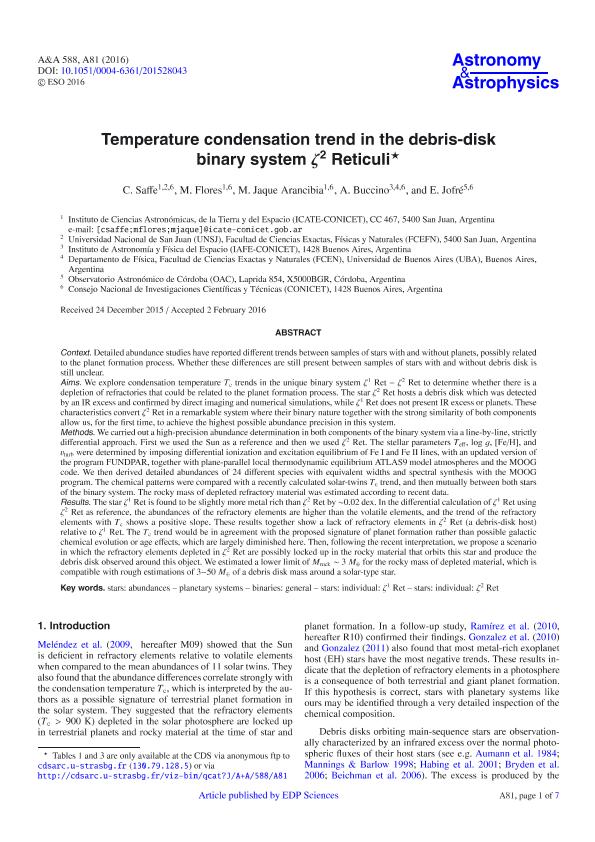Mostrar el registro sencillo del ítem
dc.contributor.author
Saffe, Carlos

dc.contributor.author
Flores Trivigno, Matias Gaston

dc.contributor.author
Jaque Arancibia, Marcelo Daniel

dc.contributor.author
Buccino, Andrea Paola

dc.contributor.author
Jofre, Jorge Emiliano

dc.date.available
2017-07-28T20:07:08Z
dc.date.issued
2016-02
dc.identifier.citation
Saffe, Carlos; Flores Trivigno, Matias Gaston; Jaque Arancibia, Marcelo Daniel; Buccino, Andrea Paola; Jofre, Jorge Emiliano; A temperature condensation trend in the debris-disk binary system ζ2 Ret; EDP Sciences; Astronomy and Astrophysics; 588; A81; 2-2016; 1-7
dc.identifier.issn
0004-6361
dc.identifier.uri
http://hdl.handle.net/11336/21580
dc.description.abstract
We explore condensation temperature Tc trends in the unique binary systemZet1 Ret - Zet2 Ret, to determine whether there is a depletion of refractories,which could be related to the planet formation process. The star Zet2 Ret hostsa debris disk which was detected by an IR excess and confirmed by directimaging and numerical simulations, while Zet1 Ret does not present IR excessnor planets. We carried out a high-precision abundance determination in bothcomponents of the binary system via a line-by-line, strictly differentialapproach. The stellar parameters Teff , log g, [Fe/H] and vturb were determinedby imposing differential ionization and excitation equilibrium of Fe I and FeII lines, with an updated version of the program FUNDPAR. The star Zet1 Retresulted slightly more metal rich than Zet2 Ret by 0.02 dex. In thedifferential calculation of Zet1 Ret using Zet2 Ret as reference, theabundances of the refractory elements resulted higher than the volatileelements, and the trend of the refractory elements with Tc showed a positiveslope. These facts together show a lack of refractory elements in Zet2 Ret (adebris-disk host) relative to Zet1 Ret. The Tc trend would be in agreement withthe proposed signature of planet formation (Melendez et al. 2009) rather thanpossible Galactic Chemical Evolution or age effects, which are largelydiminished here. Then, following the interpretation of Melendez et al. (2009),we propose an scenario in which the refractory elements depleted in Zet2 Retare possibly locked-up in the rocky material that orbits this star and producethe debris disk observed around this object. We estimated a lower limit ofMrock = 3 Me for the rocky mass of depleted material, which is compatible witha rough estimation of 3-50 Me of a debris disk mass around a solar-type star.
dc.format
application/pdf
dc.language.iso
eng
dc.publisher
EDP Sciences

dc.rights
info:eu-repo/semantics/openAccess
dc.rights.uri
https://creativecommons.org/licenses/by-nc-sa/2.5/ar/
dc.subject
Stars: Abundances
dc.subject
Stars: Planetary Systems
dc.subject
Stars: Binaries
dc.subject
Tars: Individual: Ζ 1 Ret ( = Hd 20766), Ζ 2 Ret ( = Hd 20807
dc.subject.classification
Astronomía

dc.subject.classification
Ciencias Físicas

dc.subject.classification
CIENCIAS NATURALES Y EXACTAS

dc.title
A temperature condensation trend in the debris-disk binary system ζ2 Ret
dc.type
info:eu-repo/semantics/article
dc.type
info:ar-repo/semantics/artículo
dc.type
info:eu-repo/semantics/publishedVersion
dc.date.updated
2017-07-27T12:48:39Z
dc.journal.volume
588
dc.journal.number
A81
dc.journal.pagination
1-7
dc.journal.pais
Francia

dc.journal.ciudad
Paris
dc.description.fil
Fil: Saffe, Carlos. Consejo Nacional de Investigaciones Científicas y Técnicas. Centro Científico Tecnológico Conicet - San Juan. Instituto de Ciencias Astronómicas, de la Tierra y del Espacio. Universidad Nacional de San Juan. Instituto de Ciencias Astronómicas, de la Tierra y del Espacio; Argentina. Universidad Nacional de San Juan. Facultad de Ciencias Exactas, Físicas y Naturales. Departamento de Geología; Argentina
dc.description.fil
Fil: Flores Trivigno, Matias Gaston. Universidad Nacional de San Juan. Facultad de Ciencias Exactas, Físicas y Naturales. Departamento de Geofísica y Astronomía; Argentina. Consejo Nacional de Investigaciones Científicas y Técnicas. Centro Científico Tecnológico Conicet - San Juan. Instituto de Ciencias Astronómicas, de la Tierra y del Espacio. Universidad Nacional de San Juan. Instituto de Ciencias Astronómicas, de la Tierra y del Espacio; Argentina
dc.description.fil
Fil: Jaque Arancibia, Marcelo Daniel. Consejo Nacional de Investigaciones Científicas y Técnicas. Centro Científico Tecnológico Conicet - San Juan. Instituto de Ciencias Astronómicas, de la Tierra y del Espacio. Universidad Nacional de San Juan. Instituto de Ciencias Astronómicas, de la Tierra y del Espacio; Argentina
dc.description.fil
Fil: Buccino, Andrea Paola. Consejo Nacional de Investigaciónes Científicas y Técnicas. Oficina de Coordinación Administrativa Ciudad Universitaria. Instituto de Astronomía y Física del Espacio. - Universidad de Buenos Aires. Facultad de Ciencias Exactas y Naturales. Instituto de Astronomía y Física del Espacio; Argentina. Universidad de Buenos Aires. Facultad de Ciencias Exactas y Naturales. Departamento de Física; Argentina
dc.description.fil
Fil: Jofre, Jorge Emiliano. Consejo Nacional de Investigaciones Científicas y Técnicas; Argentina. Universidad Nacional de Cordoba. Observatorio Astronomico de Cordoba; Argentina
dc.journal.title
Astronomy and Astrophysics

dc.relation.alternativeid
info:eu-repo/semantics/altIdentifier/url/https://www.aanda.org/articles/aa/abs/2016/04/aa28043-15/aa28043-15.html
dc.relation.alternativeid
info:eu-repo/semantics/altIdentifier/doi/http://dx.doi.org/10.1051/0004-6361/201528043
Archivos asociados
